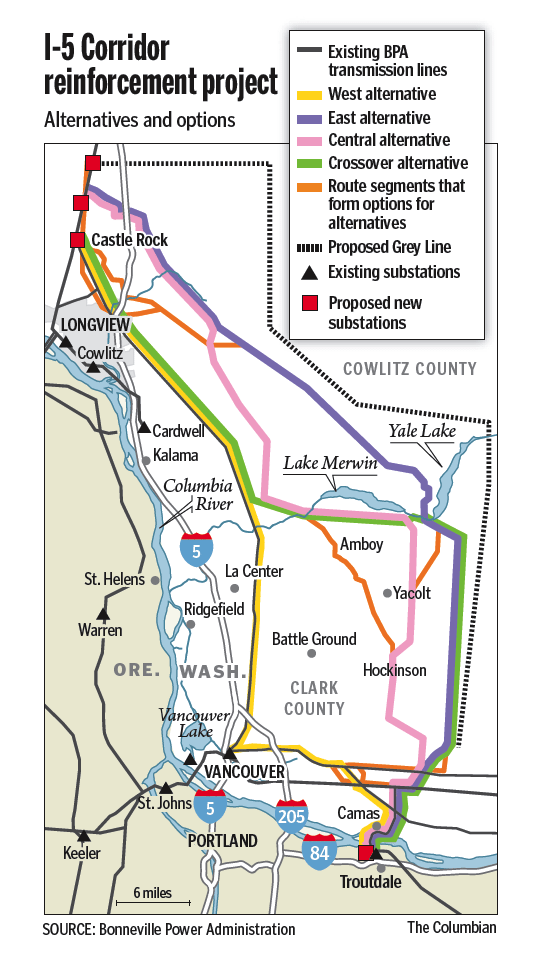Public meeting
? What: Public forum on the BPA’s proposed transmission line project through Clark and Cowlitz counties.
? When: 6 to 9 p.m. Thursday, Dec. 8.
? Where: Battle Ground Community Center, 912 E. Main St.
? On the Web: http://bpa.gov/go/i5
The Bonneville Power Administration has offered its most detailed analysis yet of a proposed transmission line through Clark and Cowlitz counties, listing new numbers on costs and property impacts of four possible routes.
The analysis also sheds new light on questions that have surrounded the 500-kilovolt line since it was first proposed in 2009:
Public meeting
? What: Public forum on the BPA's proposed transmission line project through Clark and Cowlitz counties.
? When: 6 to 9 p.m. Thursday, Dec. 8.
? Where: Battle Ground Community Center, 912 E. Main St.
? On the Web:http://bpa.gov/go/i5
• The cheapest of the BPA’s four routes is the west alternative into Vancouver, at $317 million. The central and east paths through more rural stretches of both counties are most costly, with price tags of $407 million and $406 million, respectively.
• Fifty-eight miles of the east route cuts across private property — that includes land held by timber companies — compared with 48 miles of the central route and 27 miles of the
crossover route. For the west route, mostly on existing federal right of way, that number is 10 miles.
• The central and east routes both would impact close to 1,200 acres of forest land, clearing more than 900 acres because of new right of way.
• Previously released numbers show the west route passes within 500 feet of more than 3,000 homes, by far the most of the four main routes. This week’s analysis shows the urban route would also come within 500 feet of three schools and two day care facilities.
The release comes less than a week before a Thursday public forum in Battle Ground inviting citizens to weigh in on the project. The information will be included in the project’s draft environmental impact statement due out next spring. The BPA simply wanted to get the latest data out to people as soon as possible, said agency public involvement specialist Maryam Asgharian.
“A lot of this was information that we were working on,” she said. “Because we have it available now, we wanted to make it available.”
Multiple citizen groups with health and property concerns have pressed project officials for much of the last two years, often pushing for very different outcomes. And as with previous steps in the process, the new analysis seemingly did little to change minds in the public tug-of-war over where to put the line.
For A Better Way for BPA, the new numbers confirmed the group’s support of the west route in Vancouver, said chairwoman Cheryl Brantley. The homes near that line are already close to an existing — albeit much smaller — transmission line, and Brantley noted a $90 million cost difference between that option and one of the rural lines that tread directly on much more private property.
“That’s a lot of money,” Brantley said. “Those costs will be reflected in our rates.”
For Another Way BPA and two sister groups, Citizens Against the Towers and the Yale Valley Coalition, the BPA’s latest analysis is disappointing for what it doesn’t include — the groups’ proposed “Grey Line” that would push the project farther north and east than any of the BPA’s four main routes and variations from them.
Another Way BPA chairman Terry Constance said that option would come within 500 feet of only 11 homes, and creates less of an impact to people than any other option on the table. He and others say they don’t feel the idea has gotten a fair shake.
“We want to avoid all of the places where people live,” Constance said. “Our mission has never really changed … no lines in populated areas.”
The BPA has said the Grey Line is being considered, but the agency hasn’t decided whether to include it in next year’s environmental impact statement. Asgharian reiterated that stance Friday.
The analysis released this week goes into much greater detail than simply cost and property. It also lists data on various wildlife habitats in the path of the power lines, wetlands, archaeological sites, even “private parcels with ornamental trees” that would be trimmed or removed on each route.
The Dec. 8 public forum at the Battle Ground Community Center is likely to draw a sizable crowd. The BPA sent notices to “thousands” of residents near the project area, Asgharian said, and citizen groups have rallied their own ranks in advance of the gathering.




